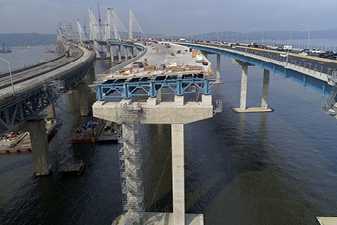|
By Katie Cross, Associate, Blakey & Agnew
Although it came almost a year later than originally hoped, we finally saw the release of the White House's promised infrastructure plan in early February. In the plan, titled "Legislative Outline for Rebuilding Infrastructure in America," the President calls for $200 billion in direct Federal investment over 10 years to leverage investments from states, localities and private entities, which the Administration says will result in around $1.5 trillion in total investment. While the proposal does not include a funding mechanism, the Administration has said it will work with Congress to develop one. The Outline proposes three new programs that would fund projects of all different infrastructure types including roads, bridges, ports, airports, rail, and non-transportation infrastructure.
The largest of the three new programs, titled the Infrastructure Incentives Program (IIP), would receive 50 percent of the proposed direct Federal funding, totaling $100 billion, to be distributed through a competitive grant program. Criteria for the program focus on the project's ability to leverage non-Federal funding, limiting the total amount of Federal investment to 20 percent. The IIP would be administered by the U.S. Department of Transportation (USDOT), the Army Corps of Engineers (USACE), and the Environmental Protection Agency (EPA).
The second largest program is titled the Rural Infrastructure Program and would receive $50 billion. 80 percent of the funds available to the program would be distributed directly to the states through a formula program while the remaining 20 percent would be used for a competitive grant program.
The third proposed program is the Transformative Projects Program, which would receive $20 billion for a competitive grant program to invest in innovative projects. The Outline also dedicates $20 billion to the expansion of existing financing programs, including the Transportation Infrastructure Finance and Innovation Act (TIFIA) program, the Railroad Rehabilitation and Improvement Financing (RRIF) program, the Water Infrastructure Finance and Innovation Act (WIFIA), and the use of private activity bonds (PABs). $10 billion would be used to establish a Federal Capital Revolving Fund, dedicated to financing purchases, construction, or renovation of federally owned domestic property.
Beyond proposing funding for projects, the Outline also suggests policy changes intended to streamline the permitting process and to make more funding options available for infrastructure. This includes lifting restrictions for tolling on Interstate highways and creating flexibility to sell certain federal assets to states or private entities. The Outline has over 15 pages of permitting reforms, which include but are not limited to: establishing a one agency, one decision policy in environmental reviews; allowing states to assume more permitting responsibilities beyond NEPA; and shortening the statute of limitations for all permitting projects to give stakeholders 150 days to sue the project sponsor
|

instead of two years.
Response to the Outline was mixed, with some expressing worries over the lack of payfors and others concerned that the direct Federal investment would not be able to leverage non-Federal funding to the extent predicted. Still, many praised the Outline as the starting point to a longer conversation about an infrastructure bill between Congress and the Administration. In that vein, Congress began scheduling hearings on the potential bill. In early March, Secretary of Transportation Elaine Chao testified before multiple Congressional committees on the Administration's proposal. During the hearings, she defended the plan and sought to answer questions regarding its ability to meet the $1.5 trillion level of leverage predicted.
Congress is not limiting its input to hearings. On March 6, a Coalition comprised of 60 House Democrats committed "to pro-economic growth, pro-innovation, and fiscally responsible policies… seeking to bridge the gap between left and right" released their own principles for an infrastructure plan. They called for fixing the Highway Trust Fund, addressing existing infrastructure deficiencies, and fostering innovation through permitting and regulatory streamlining as well as innovative funding tools. On March 7, Senate Democrats released their plan calling for $1 trillion in direct federal investment over 10 years. Among other initiatives, the plan would provide $40 billion for a Vital Infrastructure Program to use competitive grants to invest in megaprojects for a variety of infrastructure types, including roads, rail, public transportation, airports, ports, and intermodal facilities. It also calls for $10 billion to expand the Transportation Investments Generating Economic Recovery (TIGER) grant program and $30 billion to modernize ports and waterways.
In terms of timeline for the passage of any infrastructure bill: according to Politico, a House Transportation and Infrastructure Committee aide said they hope to markup infrastructure legislation by early summer and pass a bill in the House before the annual August recess. During the Congressional hearings, some Senators and Representatives were optimistic that a bill would pass by the end of 2018. However, some Members of Congress have expressed fears that Congress has too much on its schedule and not enough time to be able to pass an infrastructure bill this year, especially with mid-term elections approaching.
Blakey & Agnew, LLC is a public affairs and
communications consulting firm based in
Washington, DC.
|

